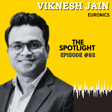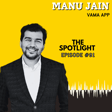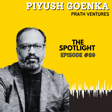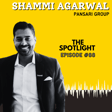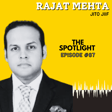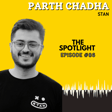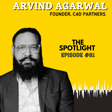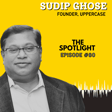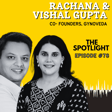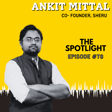Become a Creator today!Start creating today - Share your story with the world!
Start for free
00:00:00
00:00:01

Making Wealth Do Good | Smita and Ram @ Rang De
Smita and Ram launched a not-for-profit initiative to help artisans and farmers access affordable credit. This initiative evolved into Rang De, a social P2P lending platform offering people the chance to invest in loans for those seeking to improve their livelihoods, providing both financial and social returns.
Transcript
Introduction and Founding Story
00:00:00
Speaker
Hi, everyone. I'm Ram. Hi, I'm Smrita. We are both co-boundals of Rangdi.
00:00:20
Speaker
You would have surely heard of business tycoons like Bill Gates and Warren Buffett who earned a lot of wealth and then spent the last few decades of their lives doing philanthropic work and giving away their wealth. In this episode, we speak to a couple who actually did the opposite.
Business Model and Financial Inclusion Focus
00:00:34
Speaker
They started a not-for-profit initiative to help rural artisans and samos to get loans and they eventually converted this into a corporation in order to scale up the impact.
00:00:44
Speaker
Ram and Smita are the founders of Rangde, a peer-to-peer lending fintech startup that is the business of doing good without compromising on financial returns. Rangde allows people with wealth to make loans to people who need funds to generate their livelihood. And thereby, Rangde offers both financial returns and social returns on your money. Stay tuned for this conversation and subscribe to The Founder Thesis Podcast on any audio streaming app for more stories about changing the world through entrepreneurship.
00:01:20
Speaker
So, you know, just for some context, while I'll go through the whole journey of how you built up Ranbir, but, you know, what would be like an elevator pitch of Ranbir? So only 12.8% or this is the recent data from the World Bank.
00:01:40
Speaker
Only 12.8% of India's eligible population have access to formal credit. This includes all credit cards as well. What we're trying to do at Rangh De is use of revolutionary
00:01:55
Speaker
regulation in the form of NBFC P2P, which allows an Indian to lend money to a fellow unbanked Indian and make them financially included. That's what we do at wrong day. We are a peer-to-peer lending platform for the unbanked. Okay. So for the unbanked means
00:02:15
Speaker
This is not something you're doing for urban population, white collar, that's not your target here. Because urban white collar folks or even traders, SMEs, all are not exactly unbanked, right?
00:02:29
Speaker
Yes, so our focus is mostly rural entrepreneurs, artisans, and farmers. But even in urban areas, if at all we work, we look at existing financing gaps. If traditional financial institutions have failed people, that's where we intervene and see how do we actually customize loan products to make it both affordable and accessible. So in some sense, we are location agnostic, but right now we
00:02:57
Speaker
are spread out mostly in the rural areas.
Inspiration and Early Challenges
00:03:01
Speaker
Okay, got it. So let's talk about the journey. What led to the birth of the idea of Rangh Deh? Had you already got married and then you started Rangh Deh or was married second and Rangh Deh came first? Just tell me a bit of that backstory.
00:03:24
Speaker
Yeah. So, we were, even much before getting married, we had this very strong desire to do something meaningful in the social space. The motivation was different for both of us. Mada comes from a social world background. She's done her master's in social work. And in fact, that's how we met. I was volunteering for a non-crosshead where Mada was working.
00:03:48
Speaker
Okay, so in my case, it was a completely different motivation. I studied in the engineering college where it was infamous for campus violence. I quite unintentionally ended up doing a fundraiser for an orphanage.
00:04:06
Speaker
but with a small change in the format. And the change was to also celebrate the birthdays of children in this orphanage as part of this fundraiser in the college campus. And that small change changed everything overnight. Overnight, we had peace in the campus.
00:04:27
Speaker
And that had a very profound impact on me because the takeaway for me personally was that all of us have empathy in us. We may live an entire lives, not expression, because no one presented us with an opportunity. This fundraiser became a universal expression of empathy for the entire campus. So it was just a matter of time. I wanted to take a plunge into the social space. And when I met Suthar, she had similar thoughts and she wanted to really
00:04:56
Speaker
make an impact in the social space. And we're quite agnostic, you know, we were not too worried about what that would be. And with that thought, you know, we got married and soon after we went both to the UK, we started living in a tiny village called Kindlington, four miles away from Oxford. Why UK? Like, did you get a job there?
00:05:14
Speaker
Yeah, yeah, a job. You've got a job. We never studied at Oxford. We worked there. Oh, wow. Okay. Yeah. And that is where, you know, we were living in this beautiful village, got convicted. And because for the first time we understood after living there for a few months, for the first time, we understood what people meant back in India when they said India is a developing country.
00:05:41
Speaker
Because for the first time, we were experiencing what a developed state looks and feels like. And we couldn't help ask ourselves this question, how much time would it take for India to get there? And we struggled with that answer. And that is when we made a promise. We said, well, two years it is. In two years, we'll move back to India and start something meaningful in the social space. And what that something would be, as always, it never bothered us because when you come from a country like India, you're spoilt for choice.
00:06:10
Speaker
There's so many issues could pick up and spend your whole lives solving it. So that is how we went about planning our journey into the social space. And when 2006 came, we did several ideas by then.
00:06:31
Speaker
child labour, rural unemployment, the empathy gap which we have in our country for the problems that India faces. And then coincidentally, D-2006 also was the year when Marvel dinner sent the Grameen back for the Nobel Peace Prize and the announcement was just made. Our initial response was, well, good for Bangladesh. India doesn't need microcredit because we are far ahead of Bangladesh.
00:06:59
Speaker
But when we go a little bit, we noticed that India was actually behind Bangladesh when it came to financial accuracy. Only 7.7% of India's eligible population had access to credit. And we also stumbled across an article on readif.com, which spoke about how borrowers were borrowed from a micro-frenzied sea ship in Hyderabad, how some of them had committed suicide.
00:07:27
Speaker
and how the interest rates they were being were very, very high. And that is when, you know, we felt that something was not right. On one end, Momodenis was talking about this really pristine model of serving my two credit.
00:07:49
Speaker
to ensure that the poor are able to overcome poverty on their own, and to do this sustainably. And on the other end, in India, it was being done to maximize fraud. So that is where we felt that maybe we should do something about it. And at around the same time, peer-to-peer platforms are taking off, one in the UK, in the US. And we felt that perhaps this construct
00:08:17
Speaker
could be a great alternative to traditional credit. Because not only it would allow us to raise affordable and more sustainable credit for the communities, but it would also help bridge the massive empathy gap which we have in our country. Because as opposed to charity, when you're investing in somebody's future in the form of credit, you can't help notice who that person is.
00:08:47
Speaker
when they start repaying. At some point you would notice who that person and we felt that could be a very powerful take away from this whole model and we zeroed down on the idea and that's how run they came into existence.
00:09:04
Speaker
Okay. I believe like 2009 is when you started Ranghi, right? Yes. 2008. 2008, okay. At that time, I don't think there was any regulation around it. I think the regulations came pretty recently.
00:09:22
Speaker
Yes, absolutely. So, we were the first ones to start peer-to-peer lending in the country and of course, there was no precedence to it. But we still went ahead thanks to the support of a lot of thought leaders, especially Dr. Nachiket Moore.
00:09:38
Speaker
And because we just had an idea and we didn't know how to actually go about setting this up. And that's when we realized that there is no legal clarity because of the lack of regulation. But thanks to the support that we received from the thought leaders in the space, we decided to still go ahead
00:09:57
Speaker
with the idea, set it up as a non-profit because, you know, RBI or anybody does not really regulate non-profits. So we thought we should give it a shot and see, you know, how far we go. So until 2017, we operated as a non-profit and an unregulated peer-to-peer lending platform.
00:10:15
Speaker
Okay. Okay.
Community Engagement and Platform Development
00:10:18
Speaker
Got it. Okay. So is there any like the reason to start as a nonprofit is easier to launch or like why started as a nonprofit?
00:10:32
Speaker
One of the reasons, but then not the primary reason. The primary reason was because we were mission-driven and we had a purpose which was how do we actually lower the cost of credit. And we had seen enough examples where well-meaning initiatives that started as nonprofits
00:10:52
Speaker
Once they moved to transition into for-profit entities, they had moved away and drifted away from their mission. So that was actually the core reason why we stuck to being a non-profit because we said we are here to actually lower the cost of credit. And the non-profit model was the best way to actually build on our mission. And you're still a non-profit? No.
00:11:20
Speaker
We transitioned. So, so what are things, you know, I think it's very early days and you also advised, um, to be honest, I think the structure did not matter to us as much as I mentioned, what mattered was the outcomes and what would allow us to get there. Uh, and, uh, and, and it's just untested, you know, we're getting into untarted directory, um, absolutely, um, uh,
00:11:50
Speaker
no idea, no precedent of how, you know, it won't work. And we were literally, you know, we were willing to jump for the steep gift and build something and hope that we land safely. So that was honestly the approach. But what we really were paranoid about was the purpose of why you're doing, you know, what we wanted.
00:12:19
Speaker
what we wanted to do because the purpose was very clear. We wanted to make it more affordable and accessible. Both were challenges because one was the cost, the other one was the whole cookie cutter model of credit in India because the communities were never given the choice
00:12:40
Speaker
when it came to credit. And what I mean by choice is they are able to choose how much, well, for how long and on what terms they want to repay.
00:12:51
Speaker
And this is a choice that you all take for granted to a financially included. But once you are on the other side, this is something which is blatantly missing. So we wanted to address both these issues through the model. And then as you mentioned, 2017 is when the RBI came out with guidelines to regulate peer-to-peer lending.
00:13:17
Speaker
In a way, your 0 to 1 journey is still 2017 and then 2017 is where probably the 1 to 100 journey starts, I'm guessing. So, give me a summary of the 0 to 1 journey in terms of... I'm guessing these would have been the key challenges. You would need a...
00:13:35
Speaker
way to, you would need some sort of a go-to-market strategy like to get investors slash lenders on board. You would need a way to find the right borrowers and to do some sort of credit and the writing on them and then you would need some sort of a
00:13:52
Speaker
a way to do this at scale, you know, using technology and things like that. How did you solve each of these pieces in the puzzle? And is there any piece of the puzzle which I'm missing? No, that's exactly what we had to figure out. So I'll talk about
00:14:12
Speaker
the social investor bit on how did we actually start to get lenders on board because like you rightly said, this was a time when a concept like this was really unheard of and plus digital marketing or anything was still in its very nascent stages.
00:14:31
Speaker
So what we actually did was in some sense, both Ram and I started to evangelize for this model and what we were trying to do. So we were pretty much out there and every startup event, back then there was a new format of event called the Unconference style of events where anybody could actually go and speak about something that they were doing. So every single opportunity that came out there, we were there.
00:15:01
Speaker
So it was purely offline and we started to realize that a lot of peers started to resonate with this idea. And there were people coming and telling us that, you know, God, I always wanted to start something like Ranthi, but I never had the courage to do it. And now that you guys have started it, how can we actually join in? So our early adopters included people like Megan, who went on to be a part of Flipkart.
00:15:29
Speaker
So we had a lot of people who were not just our social investors, but our early think tankers as well. So I remember making, you know, doing a session for me on SEO, you know, how would it work? So they were early adopters, they were early think tankers, and gradually the word started to spread. So, you know, that was in some sense our go-to-market strategy from a social investor point of view.
00:15:51
Speaker
Okay, got it. And how would they deposit money? Did you have like a... because the time when you started the plug and play payment gateway, all of these things are not really there, right? So how were you collecting the money? Well, they were there. They were. In fact, the early days, coincidentally, Flipkart was starting as well at the same time.
00:16:12
Speaker
So yeah, so we did have payment gate integration. And yeah, people used to make online payments, which also give them options to do a bank transfer, because online payments are still not mainstream at that point. But yeah, so we give them online transfers, bank transfers. Okay. Got it. Got it. Okay. And like, so the platform as such was essentially more of a backend thing. Like you didn't have like a
00:16:42
Speaker
app which people could download. We did apps but then we had a website so we pretty much had that from day one. So 26 January 2008 was when we went live but we had like a basic version of the platform. We went live with 15 borrowers from NAPUR. So we had everything when we actually went live. We had probably like an MVP version and then gradually built on it
00:17:11
Speaker
It was more polished. Absolutely. And also technology itself, Akshay, earlier it was outsourced. We had a team that helped us build it until we went live and gradually we realized that the platform is really in some sense our soul.
Operational Strategies and Partnerships
00:17:28
Speaker
It's very important for us to build this in-house. So over a period of time, we built our technology team in-house and now that's one of our core strengths.
00:17:37
Speaker
Okay, got it. You needed a website to do the matchmaking because this was a one-to-one loan. Now, most peer-to-peer companies
00:17:50
Speaker
Don't do this one-to-one kind of a loan where one borrower and one lender is patched up. They typically take money from a borrower and then give it to 100 lenders so that if there is a default from one lender, it doesn't hit that one borrower, only 1% or 5%, whatever. Some single-digit percentage of his portfolio has gone bad.
00:18:18
Speaker
Why did you choose to do this like individual to individual matchmaking kind of a loan, which is much higher in risk? Yeah, actually, we are governed by the regulation and we are not a fund. We're not an ultimate investment fund like a SEBI regulator. Given the nature of the platform and the regulation,
00:18:44
Speaker
The regulation doesn't allow us to play the role of a fund manager. So it's very clear. So what we're really doing is we're following the regulation way to develop.
00:19:03
Speaker
very closely. And what it basically says is that you are just providing a platform for social investors, lenders to invest in communities. The moment we come in and say that, okay, you give us the money, then we will manage the risk. It actually violates the first principles of the master regulation for the peer-to-peer lending in India.
00:19:31
Speaker
Okay, I had interviewed the founder of Lendian club, maybe about two years or so back. And this is what I learned from him in terms of splitting the lender's money to multiple borrowers to protect his downside.
00:19:48
Speaker
Yeah, we do that as well. Akshay, that's a very important part, but we also enable the lender to make those choices. So the platform, you know, set up in a way that, you know, the lender can actually diversify their portfolio by looking at broad filters that we have. So all the information and data that is needed for the lenders is actually available on the platform.
00:20:14
Speaker
that helps them diversify the risk anyway. But what we try and do is enable that the lender is empowered to make those decisions. So the flip side of this is you're putting more
00:20:30
Speaker
friction for a lender because now as a lender, it's not like I can just put my money here and forget it. Now I have to actually study. It's like active investment versus mutual fund investment and like why add this friction? Why not just manage it? Sure. So actually just to give a context here, right? So as Smita mentioned, there are multiple choices.
00:20:52
Speaker
So, one, you could choose an individual if you want to. You could put it in a fund. But this fund is not based on the returns or risk. Because the risk across the platform is something it should take very seriously. So, somebody who is credit worthy and trustworthy only
00:21:11
Speaker
they get access to the platform. So, that is addressed at an additional level. But once they come on board, the choice which we give to our social investors is invested in individual, invested in funds, which are the thematic funds. For example, there is an elephant fund, which invests in trial rules, art,
00:21:32
Speaker
tribal artisans living in the forest while using Lantana to create life-size elephants and then sell them to earn a livelihood. So, these are very thematic, right? And you're spoilt for choice. You can invest in Shilagar, you can invest in different parts of the country, but also with a beautiful theme in it. There, again, you don't have to worry, you've got up in Viscordo, and then, you know, that takes care.
00:21:57
Speaker
The other one is a geography-based fight because what you notice in our experience is we don't even claim this that people should come to Rangde to earn market return. In fact, this is the most often we ask question, why doesn't Rangde give market returns?
00:22:15
Speaker
Because when you're investing in runway, you're not investing in markets. You're actually investing in people for whom the markets have failed to work. So therefore the focus is not on the returns, even though you get 8%, even more if you reinvest it. But the focus is not on that, but the focus is on inclusion, focus is on how you're able to create livelihoods, create employment, where it really matters. Okay.
00:22:42
Speaker
Got it. Okay, so I'll revisit this when we talk about the conversion from non-profit to for-profit. But tell me about the third piece, which is borrowers. We spoke about the platform and how you got the lenders. How did you get the borrowers on? How did you scale that? What was the zero to one for that?
00:23:02
Speaker
So yes, so we work with partner organizations on the ground and initially even finding the right partners was a big challenge because we really had to figure out who is the right fit for us in terms of alignment with what we were doing. Because especially back then, the narrative was that microfinance is a great way for organizations to do well and do good at the same time.
00:23:28
Speaker
And this was a time when a lot of NGOs were becoming NPFCs, looking at, you know, how do we do more and more loans and things like that. So initially, even before the platform went live, I think for a month or two, a lot of our efforts just vented seal visits, meeting organizations, which could be potential partner organizations, understanding what the service design looks like in a typical microfinance model.
00:23:52
Speaker
And we realized after this field visit that we were very clear on who we should not partner with. Because somewhere we felt, even in those initial days, even though we were very new to credit, we felt that something was wrong in the way credit was being delivered. So we started with cost, but we realized that we also needed to revisit the entire service design.
00:24:15
Speaker
So start with only two partners initially to go live and then more as a pilot and gradually over a period of time started to look at this is the right persona of a partner for us. So the role of the partner is very critical because they are helping us curate demand, curate loan applications from the ground.
00:24:37
Speaker
And what we also believe, and this is very core to our philosophy, that credit is not equal to impact, especially for the kind of communities we work with. It's an enabler of impact. And credit, in addition to a whole lot of support services and handwording and critical to success interventions, is very, very important for the communities we work with.
00:24:59
Speaker
So when we look at partnerships, we look at, does the partner have the ability to do this? Are they already doing this? So that increases the probability of success for the investors we work with. And this we have fine-tuned over a period of time, but there are lots of trial and errors initially to get to the right kind of partners that would help us do that efficiently, as well as create the intended impact.
00:25:27
Speaker
So these partner NGOs would also act as your first credit underwriting step. They would in some way vouch for the person whom they are presenting with. What else do you do for credit underwriting?
00:25:42
Speaker
So, we also spend a lot of time and effort in finding these partners. So, we look at their own track record, working with the communities, how much social capital they enjoy with the communities, their leadership, their ethical fiber, their standing in the sector. So, there are a bunch of parameters. So, it's tough to be around their partner and even tougher to
00:26:07
Speaker
stay connected as a Ranve partner. Because once they join us, we also continuously monitor their performance. Because they may have a great organization, but they may have challenges in running the program. And if they do, then we continuously evaluate whether we should consider the partnership or not.
Regulatory Navigation and Fundraising
00:26:28
Speaker
Okay. So the partner is the primary tool for credit underwriting, like select a good partner and automatically the risk is reduced. I'm guessing the partner would also enable the collections and like managing that relationship with the borrower is all handled by the partner. And given that this is, they're not doing credit for the sake of doing credit, as Smitha mentioned. They are not,
00:26:58
Speaker
Credit is a part of their livelihood program, and we beautifully complement their own efforts, a bit in about three. So the team members who run the livelihood programs also, and of course there's also digital, entirely digital, it's a lot easier for them to manage it on their own terms.
00:27:21
Speaker
Got it. Okay. So what was your scale like in 2017 when you switched from not-for-profit to for-profit? How much was your monthly dispersal or annual dispersal by that time? How many borrowers and lenders?
00:27:41
Speaker
So yeah, we were dispersing about two crores a month. We just reached that stage for a very long time. And cumulatively, we had dispersed 80 crores in nine years to 66,000 households across 18 states. Now, very small numbers, but what is remarkable was we raised this capital from 15,000 individuals from 20 countries.
00:28:11
Speaker
and entirely by word of mouth. We had zero budgets for any market day. The focus in the initial years was to survive, to make sure the modern survives. And then after starting in 2008, we were hit by this massive crisis in 2010 when the meltdown happened in Andhra Pradesh.
00:28:34
Speaker
People looked at us and said, oh, you are also doing something like that. We said, no, we are not. But we stood our ground and we said, we're all going to abandon the ship. But we had to painstakingly build back because it took us about two years to bring that perception back. And then, yeah, so does the roller coaster ride NT-27?
00:28:59
Speaker
Okay. And what was your earning? So you offer 8% to the lender. How much do you charge from the borrower? That difference is all yours or you share with the NGO partner also. So we don't share anything with the partner and neither do we take any share from there.
00:29:21
Speaker
Okay, so that 8% which you're charging the borrower is exactly what is offered. Absolutely. And that's in the sole project in the right now, in the current party. Okay.
00:29:34
Speaker
How do you make money then? So that's an interesting story. So I'll just go back a bit when we were transitioning. We were the two challenges we had. One was we had to set up a for-profit and also raise two groves of equity in this for-profit to even submit the application to RBI for the NBFC.
00:29:58
Speaker
We were not too sure if we should go that path because we were worried about the mission drift and if you're a lender and if you want to make money, there are only two ways you can make money. Either increase the interest rate or increase the loan amount or do both, which typically ends up creating a bubble and you see this play out, not just in India, but nobody. And we didn't want to go that path because we didn't want to
00:30:28
Speaker
exploit the same communities we've set out to serve. So that is when we went back to the drawing board and did a lot of design thinking, thanks to our mentor, Professor P. Sudarshan, we were able to find an all-new business model, which had zero dependency on the interest of borrowers for our own sustainability and eventual profitability. And the model was simple. The idea was to repurpose it only from being a lender
00:30:55
Speaker
to being a platform which is providing a service to all its stakeholders. So we felt it's only fair, we charge our, in fact, partners, a one-time setup fee and an annual recurring fee to access the platform. And in fact, partners, they are engineers. And this was also a great litmus test. Because if somebody is committed to a live view program, they really need credit on their terms.
00:31:24
Speaker
Otherwise, they struggle, right? It's very tough. So what we're giving them is on tap, they're getting access to form and credit, which is affordable and also designed for their community. Okay. So they just love the idea. That is the only source? So that's one. Then we have a 2% processing fee, which the partners pick up. This is to offset some of the costs which we incur. This is part of the disbursement fee. We have a small margin there.
00:31:52
Speaker
And then the third revenue stream, which we've not introduced, but we've been testing it for a while, is to charge a small access fee from a social investor. It could be as small as 49 rupees per transaction. Like a convenience fees with your book, your ticket. Absolutely. So that would also kick in. Because the whole idea was to charge for access and not for usage.
00:32:18
Speaker
Okay, got it. This 2%, I wanted to understand that a little more processing fee, so essentially like if
00:32:28
Speaker
There is one lack of loan being disbursed. So you charge 2% of that one life for enabling the flow of the money. And some part of it would go to the payment gateway provider. Absolutely. Some part would stay. So payment gateway, then escrow account charges, virtual account charges, GST. So it's all inclusive. KYC, credit bureau checks, all inclusive. Digital signatures, everything bundled into it.
00:32:55
Speaker
You, credit bureau checks are needed because you said that the NGO partner is the primary tool for credit. We are regulated by RBI. And also contribute to the bureau. If the borrower doesn't have credit record, which would be, I guess, very common, right? Because these are rural entrepreneurs.
00:33:20
Speaker
That doesn't stop you. I mean, lack of bureau score does not stop you from. Actually, we actually celebrate when that happens. Because you're bringing someone into former credit economy. Okay. So how did you raise the money you needed in 2017 when you had to become a regulated for profit P2P? That's a great question. We really struggle because there is no such thing called social equity in the country yet.
00:33:51
Speaker
So, when we started, you know, Smita started writing email to our social investors, a large community, saying that, you know, we are on the crossroads. Most likely, we may just hand up our boots and move on because we don't have access to capitalism. Many of them responded to that email. They said, hey, if we'll be happy to invest and we're a bit, you know, anxious with us on what terms,
00:34:19
Speaker
They said, you define the terms, we will give you the money. And to our surprise, we raised 2 crores in less than a month from 23 individuals without a dog sheet.
00:34:31
Speaker
So that gave us a confidence to go ahead and file for the application. And then as you see the rest of the
Pandemic Response and Adaptation
00:34:38
Speaker
street. But the good part actually is that even today we are entirely funded by our community of social investors. We have more than 130 angels on our gap table. Who are coincidentally also majority of them first time angel investor.
00:35:02
Speaker
Amazing. Interesting. How did things change once you became a P2P and BFC? Was there any significant change in how you run the business or was it just largely entity type change?
00:35:24
Speaker
I think it was a big change because we now regulated a lot of compliance with security, deep investments in tech, all of that clearly. But also, more validation for Ande's model. We've been around in the sector for a while. Some people had known us for a while, but there was now more
00:35:51
Speaker
recognition for the model because they said, now you're regulated by RPI. We love this. So now we can work together. We don't really worry about our auditors, raising a flag, who's regulating them. So yes, a wide acceptance across the board. And coincidentally, also, soon after launching Runway, we went straight into the pandemic.
00:36:13
Speaker
I think it's the universe way of testing us, testing our resilience. And we didn't know what to do. We had just raised a bunch of loans for entrepreneurs and there was a national lockdown announced on television. So we said, okay, we can't disburse those loans. And just then we got this distress call from a group of farmers in Yavatman saying that the soybean prices have crashed.
00:36:40
Speaker
Can you give us credit for bear house financing? We said, yeah, we have to do. And overnight we raised a million rupees and we gave it to them. And those days, you know, there were things where our watch and roofs, which mushroomed overnight. And somebody mentioned there that Randa is giving loans to farmers.
00:37:00
Speaker
So many of them started reaching out saying that we also need access to credit in normal times and stuff, but in those times it's even tougher because the banks are not operating at some capacity.
00:37:12
Speaker
So we said, well, this looks like a big need there. And farmers are not affected by the lockdown because they need to still work in the fields. So that is when we reached out to NDTV and we did a telethon with them and we received overwhelming news. In a couple of hours of live telethon, we had raised 5.5 crores.
00:37:40
Speaker
of interest-free capital. That is the first time somebody was doing on national television, which bubbled up to 10 crores eventually. And you were able to serve 8400 small and marginal farmers across OT state with interest-free credit. We did this interest-free. In fact, we were the only regulated entity
00:38:03
Speaker
at that time to do interest-free loans for farmers. And in our history, also we were doing it for the first time because not because the farmers were asking for interest-free loans, but we wanted to stand with them in solidarity and say that, you know, there's a lot of uncertainty. This is our view of expressing our gratitude. Amazing.
Sustainability and Technological Investment
00:38:27
Speaker
This telethon means you went on TV and you pitched the platform and there was a link where people could go and give this. Are you under pressure to earn profits?
00:38:44
Speaker
because you have external investors. So is that there are all of these investors are aligned that we are not in it for return on investment. So, you know, actually what we're trying to do at Rangdi is set up a system for regulated beautiful platforms, not just for India, but for the entire world. We are very committed to build a platform which has got very strong unit technologies.
00:39:09
Speaker
If it plays out the way we think it will play out, it will be very profitable as well. But that is not what is driving us. That could become an unintended outcome of the value we are creating for the company. And that's a big departure because typically any social or any startup gets measured on only one metric profitability.
00:39:36
Speaker
and never gets measured on impact. And we're trying to change that narrative. Because what we're trying to do is innovate and build something at the same time. In fact, already we're getting early feelers from UK, Africa,
00:39:56
Speaker
various coalitions there saying that we see a very interesting need for something what you're doing in India in our communities, in our geographies as well. And we've politely not accepted those requests right now because you're still not done yet in terms of building a solid, robust, sustainable, profitable model without compromising our mission.
00:40:22
Speaker
Okay, how close are you to breaking even? I think it should take a couple of years. But we're getting very steady, you know, excellent product market set. We also invest in heavily in design, product and tech. And we do massive research on our users. And that is bringing you know, it's really giving us a lot of insights and, and we're very confident
00:40:49
Speaker
of building a robust model which will actually set up a great precedent, not just for social enterprises, but also for other VO2PO models around the world. What is the role of tech here? So the entire platform is digital.
00:41:09
Speaker
So for the communities, like the payment flow, one part is payment flow automation and the discovery automation, like for listing of borrowers and for allowing lenders to discover borrowers. So what else? At the community level, if you look at our partners and partner team members,
00:41:34
Speaker
the access on this technology using a mobile app. It's a Flutter app. It's actually an Android app. Yeah, so they have a device and that's entirely digital. It's secure, follows all the guidelines. Yeah, so technology at that screen. That is for Borrower KYC. Yeah, onboarding. And then there's tech for underwriting. We use AI
00:42:02
Speaker
based on the writing, we're still building those models. We have signed up with Synaptic. So that, yeah. The underwriting is happening through the NGO, right? I mean, because this is not a data rich segment that you're lending to. And that's why we're trying to build those data models, because we have a lot of alternate data sources. And now,
00:42:27
Speaker
So for example, we're looking at gender, we're looking at certain occupations, we're looking at cash flows wherever it is available. So it's a very hybrid sort of a data model that we're looking at, very conventional data related stuff, as well as the social and economic factors of where our borrowers actually came from.
00:42:51
Speaker
Now that we are trying to create partner scorecards and borrower's scorecards to see the data that we have for the last three and a half years, what are those insights that we can get from there that become inputs to the scorecard.
Comparative Advantage and Growth Strategy
00:43:06
Speaker
and then design our own early morning systems. So as we scale, it's a beautiful combination of not just what the partners are doing, but also our own systems and which is able to detect and show us early morning the science of the health of the system as well. So that's what we are building up to now. Okay, got it. Interesting. And what is your NPA rate so far?
00:43:35
Speaker
At the moment, it's about 8% and it's a little high compared to where we were a few years back. And this is largely because of a couple of geographies and communities that have been badly hit by the pandemic and they're still recovering from it. So these have not been written off. There are delayed repayments. And we hope that in the next couple of weeks, actually, there's going to be a significant decrease in the LPA.
00:44:04
Speaker
Yeah, it should average around 3% because we've worked in, as Mr. Mehta mentioned, very remote dogs in the Kyonja and very remote dogs in Nagalaya. Yeah, so the communities need extra time and it's all going to come back and Kashmir as well. Got it. Okay. This interest-free lending campaign you did, was it a one-off thing? Is it a one-off of your products?
00:44:30
Speaker
No, it's a one off stay. And yeah, it was only during that time. Okay, okay, okay. The general norm is that 8% is... So 6 to 8%, we give our partners the choice of choosing and that should be 6% or 8%. And they get to choose either or in something in between.
00:44:55
Speaker
Why don't you decide this? Why do you give a choice? Largely because... Well, we do this together. It's not like, you know, we do this in the spirit of the Pakushya, we co-create it. So, we discuss it and say that... Because the NGO would obviously want as low as possible, right? Not really. Interestingly, not really. Because, you know, in certain communities and geographies, they also want to benchmark with the bank rate.
00:45:24
Speaker
saying that in the state bank of India semi loan, if you had got it, we'd have got it at this person. So we want to do that so that they can tomorrow move on to a bank loan whenever that happens. So they want to have some parity. Absolutely. Absolutely.
00:45:43
Speaker
Okay, okay, okay. There are a lot of government schemes for credit to farmers. Are those credit schemes available only to farmers who have data like a credit score or something?
00:46:00
Speaker
Can any farmer get access to those kind of schemes? Can you just analyze those government schemes when they're lacking? What is the gap which possibly Ranve is filling, which those government schemes have currently not been able to fill? But fundamentally, as you can imagine, I think there's an issue with the design. When I say design, I'm referring to the service design and the product design.
00:46:26
Speaker
As you can imagine with any one of us, when we look at any government scheme, the red tape, the challenges we face, sadly, they get many forward if you are a small and marginal fowl. Right. Like literacy is a bad guess. Not just like literacy in the traditional sense, but like financial literacy is also a bad guess. And also
00:46:56
Speaker
Well, this is also something to be said to the government. The farmers also have this expectation that there will be a loan waiver. Because it has happened in the past. So the loans even if they're taken, if you look at the NP numbers, they're not publicly available. They're really, really not something to write home about. So there are those challenges as well.
00:47:23
Speaker
Yeah. And then, you know, then you have the other for-profit lenders, the FinTechs and the NBFCs, which are clearly have a different mandate altogether. Right. Those would be like at least double the costs of what you are preventing. Yeah, much more. Yeah. I don't think anyone would risk it. Yeah, much more than that. Sixteen, seventy percent.
00:47:44
Speaker
An organization like Avanti Finance is operating in the same space in terms of other foreign profit. But they are not able to pay. They are, of course, institutional. So their rate of interest is higher than what you'd say. Yeah, they do. And by the way, they're very good friends. We're part of the same ecosystem. And we did play a small role when they were starting up. Absolutely.
00:48:16
Speaker
But the path they have chosen is that to have a regular NVFC path and what it does is to a regular NVFC or even to a bank is that you always have a cost of capital, then you have a cost of operations and then you have a margin and then you lend money.
00:48:40
Speaker
So in a beautiful model, and that's the reason we believe in being absolutely sacrosanct when it comes to that, is to celebrate that whole fact that there is no pancaking, that there's no middle layer here. So we're removing that layer because now we're connecting an individual directly to an individual and therefore passing that entire value which you're creating directly to the company.
00:49:11
Speaker
Okay. But, you know, peer-to-peer suffers from lack of supply, right? That's the, like, if you were an institutional NBFC, then, like, lending 100 crores a month is feasible because there is money available on tap, almost, depending on your credibility and so on.
00:49:33
Speaker
But for peer-to-peer, you can't scale up at that same pace because it needs education. Or if you want to scale up, then you need to spend a lot of money on customer acquisition. I mean, it's hard to scale peer-to-peer at that same pace as what you could do with an institutional NVAC. Absolutely. And I think that's the reason why we've been here for 15 years.
00:50:02
Speaker
So think about it like the early days of e-commerce in India. No one wanted it. They said, oh, COD, we will not pay online. Yes, absolutely. Because when you created a new category, you need to be in it for the long run. And we're happy to do that. Because I think as a country, we need to solve this problem at scale.
00:50:29
Speaker
To give you a simple example of how we are moving as a country, last year, the Reserve Bank of India issued a notification saying that the interstate capital set by the Malayam Committee in 2010 for the microfinance institutions is now being revoked. Microfinance institutions' board members can now decide how much they should charge the communities who are
00:51:00
Speaker
underserved. So if we really, as a country, we need to progress, wanting to make return, as commercial, succeed. I think we've had enough of it. We have seen how that plays out, especially when you're serving communities at the base of the pyramid. We can't get rid of our economy, but we can't get all of us. If we can't get our per capita income to go up, I don't think you would have achieved that.
00:51:29
Speaker
we will have more billionaires and maybe, yeah, but as a country, we would have still failed. So, that's the idea. That's the promise. We believe the supply also is a function of many things up here, right? So, it's a function of if you're able to tell a compelling story because, see, lack of credit doesn't even surface as a problem which needs to be tackled out today.
00:51:57
Speaker
But when we step out of our homes, we see poverty everywhere. Even when they are depainting from an airline, we see people waiting, and they look so mandarish, trying to get in and clean, prepare the aircraft for the next flight. So, it's all over the place. But how do we overcome poverty here, sustainably?
00:52:24
Speaker
We feel, you know, credit could be a great enabler. So yeah, so we are not giving up as yet. Got it, got it, got it. So your path is to grow organically or do you want to raise funds and then spend those funds to acquire more lenders? Okay, so we will never be able to raise the kind of money, you know, which other duty cons raise.
00:52:54
Speaker
But we are bringing the fight to the doorstep in terms of the efforts we're putting in, in terms of our own ability to build world-class products. For example, we have a coach who is a coach for startups and Y Combinator. She's ex-Google based in Berlin.
00:53:16
Speaker
Because when we were trying to find a coach in India, we struggled. People said, okay, you're doing a great job, but well, we're tough. We don't have the time. And to our surprise, we found a coach in Berlin. So, we're leaving no stone unturned to make sure we deliver on that user experience so that people can invest and they also get to talk about it.
00:53:40
Speaker
But we are also going to look at inorganic growth strategies, which will not cost us a lot of money. We will ride on. Give me some examples. Well, let's example the telethon which we did. And we recently, thanks to Smita, we made it to the Google Accelerator. I'll let Smita talk about it.
00:54:04
Speaker
Yeah, I think at least in the last few years, what we've seen is if we have well thought through strategies to reach out to the right target audience, through the right channels, we don't need to be spending a lot of money to acquire users.
00:54:21
Speaker
And a lot of effort in the last few years has been on building our network of impact partners, ensuring that we have the ability that the money goes to the right people and it's creating the kind of impact and there's a payback as well. So now we are very, very confident to see how do we actually build the supply side and do it at scale. So we're exploring some amazing partnerships that say Google Play Store, we're looking at Google Pay,
00:54:50
Speaker
So a lot of these partnerships that are going to come together to help us do that and a lot of organic efforts as well. So we are seeing that organic content marketing is actually paying us huge, huge, huge results, huge dividends. And we are actually being able to increase our conversion rates, increase our signups with just doing that very consistently.
00:55:14
Speaker
So product, content, community building, and partnerships are four ways in which we are looking at scaling up our social investment. Google Pay could be a game changer. Essentially, you will be discoverable on the Google Pay app. People who want to invest money with impact will discover you.
00:55:37
Speaker
And that brings us to the end of this conversation. I want to ask you for a favor now. Did you like listening to this show? I'd love to hear your feedback about it. Do you have your own startup ideas? I'd love to hear them. Do you have questions for any of the guests that you heard about in this show? I'd love to get your questions and pass them on to the guests. Write to me at adatthepodium.in. That's adatthepodium.in.


